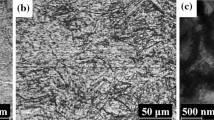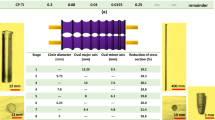Abstract
Titanium, the gold standard for dental implant materials, is distinguished by its exceptional biocompatibility; however, from a long-term perspective, titanium still lacks sufficient loading strength. Commercially pure titanium with grain size 30 μm was processed by equal channel angular pressing, and two novel mechanically improved types of titanium material with grain size 4.6 and ≤1 µm were obtained. The surfaces of these ultra-fine grained titanium samples were further mechanically treated by grinding and polishing, and their surfaces were characterized by atomic force microscopy and contact angle measurement. Osteoblast-like cells and human mesenchymal stem cells were used to evaluate the cytocompatibility of these titanium samples. The cell metabolic activity, cell number, cell area, morphology, and cell adhesion quality during the early stage (2 h) and prolonged cultivation (48 h) were determined. Both cell types displayed increased initial attachment to all tested titanium materials in comparison to reference tissue culture plastic. Importantly, results revealed that the novel titanium materials with improved strength were equivalent to the original commercially pure titanium, thus confirming their suitability for osteoblast and mesenchymal stem cell growth and proliferation. The present study proved the cytocompatibility of the novel forms of titanium with superior mechanical properties and revealed their potential for manufacturing of long-term dental implants.








Similar content being viewed by others
References
Cordova LA, Stresing V, Gobin B, Rosset P, Passuti N, Gouin F et al (2014) Orthopaedic implant failure: aseptic implant loosening—the contribution and future challenges of mouse models in translational research. Clin Sci (Lond) 127:277–293
Chrcanovic BR, Albrektsson T, Wennerberg A (2014) Immediate nonfunctional versus immediate functional loading and dental implant failure rates: a systematic review and meta-analysis. J Dent 42:1052–1059
Ren K, Dusad A, Zhang Y, Purdue PE, Fehringer EV, Garvin KL et al (2014) Early diagnosis of orthopedic implant failure using macromolecular imaging agents. Pharm Res 31:2086–2094
Gawkrodger DJ (2003) Metal sensitivities and orthopaedic implants revisited: the potential for metal allergy with the new metal-on-metal joint prostheses. Br J Dermatol 148:1089–1093
Plecko M, Sievert C, Andermatt D, Frigg R, Kronen P, Klein K et al (2012) Osseointegration and biocompatibility of different metal implants–a comparative experimental investigation in sheep. BMC Musculoskelet Disord 13:32
Browne M, Gregson PJ (2000) Effect of mechanical surface pretreatment on metal ion release. Biomaterials 21:385–392
Mishnaevsky L, Levashov E, Valiev RZ, Segurado J, Sabirov I, Enikeev N et al (2014) Nanostructured titanium-based materials for medical implants: modeling and development. Mater Sci Eng R 81:1–19
Greger M, Cerny M, Kander L, Kliber J (2009) Structure and properties of titanium for dental implants. Metalurgija 48:249–252
Niinomi M (2002) Recent metallic materials for biomedical applications. Metall Mater Trans A 33:477–486
Hallab NJ, Anderson S, Caicedo M, Brasher A, Mikecz K, Jacobs JJ (2005) Effects of soluble metals on human peri-implant cells. J Biomed Mater Res Part A 74:124–140
Greger M, Kander L, Masek V, Vlcek M (2010) Ultra fine grain titanium using for medical applications—structure and properties. In: Nanocon 2010, 2nd international conference, pp 502–507
Yu ZT, Zhang MH, Tian YX, Cheng J, Ma XQ, Liu HY et al (2014) Designation and development of biomedical Ti alloys with finer biomechanical compatibility in long-term surgical implants. Front Mater Sci 8:219–229
Schram SE, Warshaw EM, Laumann A (2010) Nickel hypersensitivity: a clinical review and call to action. Int J Dermatol 49:115–125
Valiev RZ, Estrin Y, Horita Z, Langdon TG, Zehetbauer MJ, Zhu YT (2006) Producing bulk ultrafine-grained materials by severe plastic deformation. JOM 58:33–39
Valiev RZ, Langdon TG (2006) Principles of equal-channel angular pressing as a processing tool for grain refinement. Prog Mater Sci 51:881–981
Kubina T, Dlouhy J, Kover M, Domankova M, Hodek J (2015) Preparation and thermal stability of ultra-fine and nano-grained commercially pure titanium wires using conform equipment. Mater Tehnol 49:213–217
Kubina T, Dlouhy J, Kover M, Hodek J (2014) Study of thermal stability of ultra fine-grained commercially pure titanium wire prepared in conform equipment. Metallography Xv 782:415–420
Estrin Y, Ivanova EP, Michalska A, Truong VK, Lapovok R, Boyd R (2011) Accelerated stem cell attachment to ultrafine grained titanium. Acta Biomater 7:900–906
Gittens RA, McLachlan T, Olivares-Navarrete R, Cai Y, Berner S, Tannenbaum R et al (2011) The effects of combined micron-/submicron-scale surface roughness and nanoscale features on cell proliferation and differentiation. Biomaterials 32:3395–3403
Teng FY, Ko CL, Kuo HN, Hu JJ, Lin JH, Lou CW et al (2012) A comparison of epithelial cells, fibroblasts, and osteoblasts in dental implant titanium topographies. Bioinorg Chem Appl 2012:687–792
Le Guehennec L, Soueidan A, Layrolle P, Amouriq Y (2007) Surface treatments of titanium dental implants for rapid osseointegration. Dent Mater 23:844–854
Weber HP, Cochran DL (1998) The soft tissue response to osseointegrated dental implants. J Prosthet Dent 79:79–89
Rezek B, Ukraintsev E, Kratka M, Taylor A, Fendrych F, Mandys V (2014) Epithelial cell morphology and adhesion on diamond films deposited and chemically modified by plasma processes. Biointerphases 9:031012
Pop-Georgievski O, Kubies D, Zemek J, Neykova N, Demianchuk R, Mazl Chanova E et al (2015) Self-assembled anchor layers/polysaccharide coatings on titanium surfaces: a study of functionalization and stability. Beilstein J Nanotechnol 6:617–631
Schneider CA, Rasband WS, Eliceiri KW (2012) NIH Image to ImageJ: 25 years of image analysis. Nat Methods 9:671–675
Carpenter AE, Jones TR, Lamprecht MR, Clarke C, Kang IH, Friman O et al (2006) Cell Profiler: image analysis software for identifying and quantifying cell phenotypes. Genome Biol 7:R100
Dyakonov GS, Gu CF, Toth LS, Valiev RZ, Semenova IP (2014) Microstructure and mechanical properties of continuous equal channel angular pressed titanium. In: 6th international conference on nanomaterials by severe plastic deformation (Nanospd6), vol. 63
Polyakov AV, Semenova IP, Valiev RZ (2014) High fatigue strength and enhanced biocompatibility of UFG CP Ti for medical innovative applications. In: 6th international conference on nanomaterials by severe plastic deformation (Nanospd6), vol. 63
Li HL, Oppenheimer SM, Stupp SI, Dunand DC, Brinson LC (2004) Effects of pore morphology and bone ingrowth on mechanical properties of microporous titanium as an orthopaedic implant material. Mater Trans 45:1124–1131
Mall S, Cunningham SR (2007) Fatigue behavior of integrally fabricated joints between titanium matrix composite and titanium alloy. Compos Struct 80:65–72
Zhao XC, Fu WJ, Yang XR, Langdon TG (2008) Microstructure and properties of pure titanium processed by equal-channel angular pressing at room temperature. Scr Mater 59:542–545
Broz A, Baresova V, Kromka A, Rezek B, Kalbacova M (2009) Strong influence of hierarchically structured diamond nanotopography on adhesion of human osteoblasts and mesenchymal cells. Phys Status Solidi A 206:2038–2041
Chen XY, Cai KY, Lai M, Zhao L, Tang LL (2012) Mesenchymal stem cells differentiation on hierarchically micro/nano-structured titanium substrates. Adv Eng Mater 14:B216–B223
Naddeo P, Laino L, La Noce M, Piattelli A, De Rosa A, Iezzi G et al (2015) Surface biocompatibility of differently textured titanium implants with mesenchymal stem cells. Dent Mater 31:235–243
Elias CN, Fernandes DJ, Resende CRS, Roestel J (2015) Mechanical properties, surface morphology and stability of a modified commercially pure high strength titanium alloy for dental implants. Dent Mater 31:E1–E13
Garbassi F, Mora M, Ochiello E (1994) Polymer surfaces: from physics to technology, 1st edn. Wiley, New York
Ponsonnet L, Reybier K, Jaffrezic N, Comte V, Lagneau C, Lissac M et al (2003) Relationship between surface properties (roughness, wettability) of titanium and titanium alloys and cell behaviour. Mater Sci Eng C 23:551–560
Webb K, Hlady V, Tresco PA (1998) Relative importance of surface wettability and charged functional groups on NIH 3T3 fibroblast attachment, spreading, and cytoskeletal organization. J Biomed Mater Res 41:422–430
Flahaut E, Durrieu MC, Remy-Zolghadri M, Bareille R, Baquey C (2006) Investigation of the cytotoxicity of CCVD carbon nanotubes towards human umbilical vein endothelial cells. Carbon 44:1093–1099
Zhao LZ, Mei SL, Chu PK, Zhang YM, Wu ZF (2010) The influence of hierarchical hybrid micro/nano-textured titanium surface with titania nanotubes on osteoblast functions. Biomaterials 31:5072–5082
Kubo K, Tsukimura N, Iwasa F, Ueno T, Saruwatari L, Aita H et al (2009) Cellular behavior on TiO2 nanonodular structures in a micro-to-nanoscale hierarchy model. Biomaterials 30:5319–5329
Klein MO, Bijelic A, Toyoshima T, Gotz H, von Koppenfels RL, Al-Nawas B et al (2010) Long-term response of osteogenic cells on micron and submicron-scale-structured hydrophilic titanium surfaces: sequence of cell proliferation and cell differentiation. Clin Oral Implant Res 21:642–649
Guida L, Oliva A, Basile MA, Giordano M, Nastri L, Annunziata M (2013) Human gingival fibroblast functions are stimulated by oxidized nano-structured titanium surfaces. J Dent 41:900–907
Maghni K, Nicolescu OM, Martin JG (1999) Suitability of cell metabolic colorimetric assays for assessment of CD4+ T cell proliferation: comparison to 5-bromo-2-deoxyuridine (BrdU) ELISA. J Immunol Methods 223:185–194
Zinger O, Anselme K, Denzer A, Habersetzer P, Wieland M, Jeanfils J et al (2004) Time-dependent morphology and adhesion of osteoblastic cells on titanium model surfaces featuring scale-resolved topography. Biomaterials 25:2695–2711
Acknowledgements
This work was supported by the projects CZ.1.05/2.1.00/03.0076, CZ.1.05/2.1.00/03, and CZ.1.05/1.1.00/02.0109 of the European Regional Development Fund, National Sustainability Program I (NPU I) Nr. LO1503 provided by the Ministry of Education Youth and Sports of the Czech Republic, project NT/13297-4 provided by GrantAgency of the Ministry of Health of the Czech Republic, project PRVOUK-P24/LF1/3 of First Faculty of Medicine and project PRVOUK P36 of Faculty of Medicine in Pilsen, and the program of support and co-operation of companies and universities in the Pilsen region called “Innovation Vouchers.”
Author information
Authors and Affiliations
Corresponding author
Rights and permissions
About this article
Cite this article
Ostrovska, L., Vistejnova, L., Dzugan, J. et al. Biological evaluation of ultra-fine titanium with improved mechanical strength for dental implant engineering. J Mater Sci 51, 3097–3110 (2016). https://doi.org/10.1007/s10853-015-9619-3
Received:
Accepted:
Published:
Issue Date:
DOI: https://doi.org/10.1007/s10853-015-9619-3




